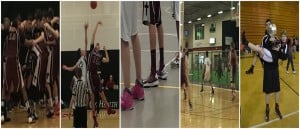Connected Learning MOOC (#CLMOOC) Make Cycle #6 – The 5-Image Story
The theme of the final week of #CLMOOC 2014 is “the 5-image story.” As I browsed the examples provided by the CLMOOC team, I began to ponder how authors decide on the stories they are going to tell, regardless of the tools they use. I know for myself, the story needs to reflect something about myself; things/people I value, ideas that intrigue me, pursuits I enjoy, etc.
So, for my “big” 5-image story project, I decided to reflect an activity that has been integral to my life for the past several years. My 15-year-old son has become serious in his pursuit of basketball. Once a “dabbler,” he now plays with a travel league, and spends time off-season improving his skills and conditioning. He and I have spent hundreds of hours on the road, attending practices, games, and tournaments.
I have never played team sports, and am clueless about many of them. I know something about basketball, at least the basic rules. The nuances… not so much. So, I began this journey with my son as an observer and sometime cheerleader. I still fill those two roles, but have also acquired a better understanding of the game, and have established some fine friendships with other parents.
Therefore, I felt that highlighting basketball would reflect a portion of my everyday life, my love for and support of my son, and a sport that is relatively prominent in the landscape of our country.
Interestingly, I posted this collage of five photos in the #CLMOOC community, and the universal response was that my photo story emphasizes the vertical aspects of basketball. Wow! I did not consciously focus on this, so maybe my “mind’s eye” was guiding me?
In verbal terms, I was identifying some components of a basketball game: the huddle, the tip-off, individuality, moving the ball around the court, victory. I was trying to identify the dichotomy of individuals seeking to differentiate themselves, whilst also contributing their unique capabilities to a team effort.
In some respects, I find this illustration parallels the American culture. We identify with this nebulous ideal of “American,” including flag-waving and cheering on our favorite sports teams, while simultaneously asserting our right to be individuals, with divergent values and goals.
As I evolved my collage of five still photos into a more fluid story, I encountered the frustration of technology-that-does-some-good-things-but-not-others. I first tried ThingLink, but quickly became frustrated. I need to consult with my CLMOOC compatriots to figure this out. Maybe the lesson for me as an educator is to ensure I have a basic understanding of any of the tools I ask my students to use.
Then, I turned to Zeega. Initially, I was under-impressed, but continued to experiment. I figured out I could superimpose audio using Soundcloud, and that I could use Flickr images and Giphy .gifs to enhance my story. The chosen elements are layers that can be added, removed, and “faded out” with a few keystrokes. After a bit of a learning curve, I began to get the hang of the tool, and started to have fun.
The beauty of the many technology tools available to even the novice user is that there is instant feedback on one’s creation. I went through several iterations of adding elements, deciding I liked them (or not), then modifying my Zeega to correctly reflect the story I wished to tell. I chose and discarded elements with abandon. This was not a methodical figure-it-all-out-and-put-it-together, but rather a free-flowing trial-and-error approach.
My final result (http://zeega.com/167226) is not “perfect,” but overall it depicts my most important ideas about the sport of basketball. I would love to hear your reactions!
